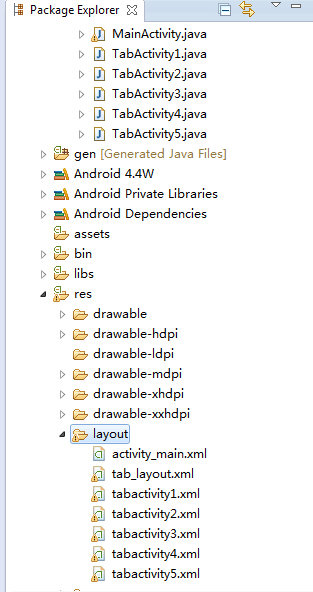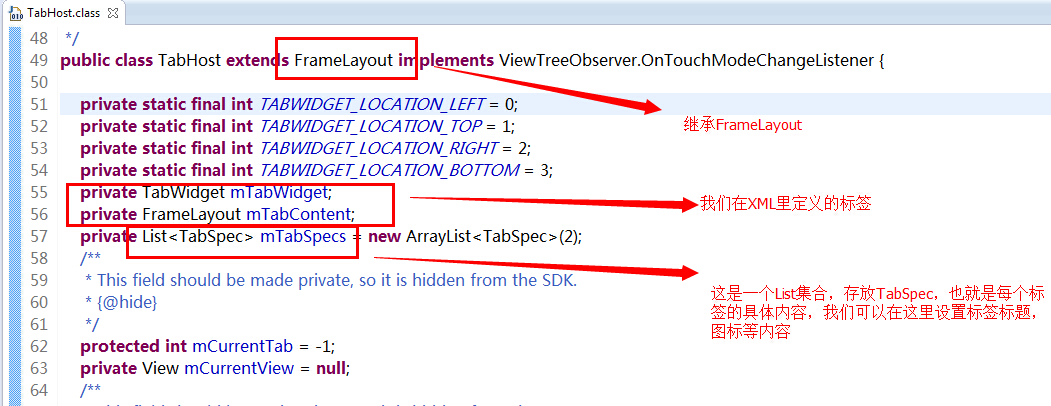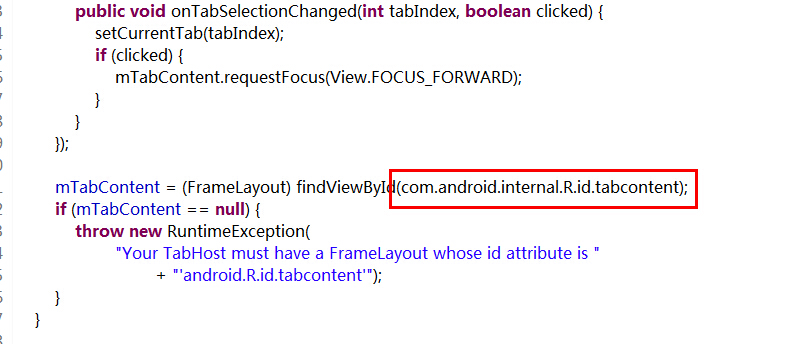http://www.cnblogs.com/lichenwei/p/3974009.html
什么是TabHost?

TabHost选项卡,说到这个组件,不得不先说一件事情,翻翻谷歌提供给我们的API,我们可以发现这样的一段话:

它告诉我们,这个组件在安卓4.0之后已经被废弃了,建议我们新的程序应该使用Fragment组件来代替它。
其实并不出乎意料,使用过TabHost的朋友应该都知道:
1、它的设计违反了Activity单一窗口原则,它可以同时加载多个Activity,然后再它们之间进行来回切换。
2、有个很致命的问题就是当我们点击别的选项时,按下Back后退键,它会使整个应用程序都退出,而不是切换到前一个选项卡,虽然我们可以在主程序里覆写OnKeyDown这个方法,但这样就会导致每一次按下Back后退键都只能回到第一个选项菜单。
但作为开发者,这个具有历史里程碑的组件,我们还是需要去掌握下,下面给几张图来看下今天要实现的效果:



下面附上代码(注释很详细)
实现TabHost有两种方式:
方式一:直接让一个Activity程序继承TabActivity类(通过getTabHost取得实例);

activity_main.xml(为了使选项卡显示在屏幕下方,这里采用了相对布局)
1 <TabHost xmlns:android="http://schemas.android.com/apk/res/android" 2 android:id="@+id/mytabhost" 3 android:layout_width="fill_parent" 4 android:layout_height="fill_parent"> 5 6 <!-- 需要一个布局管理器 --> 7 8 <RelativeLayout 9 android:layout_width="fill_parent" 10 android:layout_height="fill_parent" 11 > 12 13 <!-- 14 由于TabHost是继承于FrameLayout,所以需要一个FrameLaytout布局(内容页) ,id 15 必须为tabcontent 16 --> 17 18 <FrameLayout 19 android:id="@android:id/tabcontent" 20 android:layout_width="fill_parent" 21 android:layout_height="fill_parent" 22 > 23 </FrameLayout> 24 25 <!-- TabWidget必须标签,用来存放tab标签,且id必须为tabs --> 26 27 <TabWidget 28 android:id="@android:id/tabs" 29 android:layout_width="fill_parent" 30 android:layout_height="wrap_content" 31 android:background="@drawable/tab_widget_background" 32 android:layout_alignParentBottom="true" 33 > 34 </TabWidget> 35 36 </RelativeLayout> 37 38 </TabHost>
TabHost的布局的文件必须遵循下面几点:
1、所有的用于标签配置的文件,必须以“<TabHost>”为根节点;
2、为了保证标签页和标签内容显示正常(例如:标签提示要放在标签显示内容之上)则可以采用一个布局管理器进行布局(例如:LinearLayout,RelativeLayout..)
3、定义一个“<TagWidget>”的标签,用于表示整个标签容器,另外在定义此组件ID为“tabs”,表示允许加入多个标签



1 <?xml version="1.0" encoding="utf-8"?> 2 <LinearLayout xmlns:android="http://schemas.android.com/apk/res/android" 3 android:layout_width="wrap_content" 4 android:layout_height="wrap_content" 5 android:gravity="center_horizontal" 6 android:background="@drawable/tab_selector" 7 android:orientation="vertical" > 8 9 <ImageView 10 android:id="@+id/image" 11 android:layout_width="wrap_content" 12 android:layout_height="wrap_content" 13 android:padding="3dp" /> 14 15 <TextView 16 android:id="@+id/title" 17 android:layout_width="wrap_content" 18 android:layout_height="wrap_content" 19 android:textColor="@android:color/white"/> 20 21 </LinearLayout>
3、一个选择器,用于美观效果
tab_selector.xml
1 <?xml version="1.0" encoding="utf-8"?> 2 <selector xmlns:android="http://schemas.android.com/apk/res/android" > 3 <item 4 android:state_pressed="true" android:drawable="@drawable/tab_item_p" 5 ></item> 6 <item 7 android:state_selected="true" android:drawable="@drawable/tab_item_d" 8 ></item> 9 10 </selector>
4、跳转Activity的布局文件(由于基本一致,这里只给出其中一个)
tabactivity.xml
1 <?xml version="1.0" encoding="utf-8"?> 2 <RelativeLayout xmlns:android="http://schemas.android.com/apk/res/android" 3 android:layout_width="match_parent" 4 android:layout_height="match_parent" > 5 6 <LinearLayout 7 android:layout_width="match_parent" 8 android:layout_height="match_parent" 9 android:orientation="vertical" > 10 11 12 <TextView 13 android:id="@+id/title" 14 android:layout_width="wrap_content" 15 android:layout_height="wrap_content" 16 android:text="我是界面1"/> 17 </LinearLayout> 18 19 </RelativeLayout>
1 package com.example.tabhosttest;
2
3 import android.app.ActivityGroup;
4 import android.content.Intent;
5 import android.os.Bundle;
6 import android.view.View;
7 import android.widget.ImageView;
8 import android.widget.TabHost;
9 import android.widget.TabHost.TabSpec;
10 import android.widget.TextView;
11
12 public class MainActivity extends ActivityGroup{
13
14 private TabHost tabHost;//声明一个TabHost对象
15
16 //资源文件
17 private Class activitys[]={TabActivity1.class,TabActivity2.class,TabActivity3.class,TabActivity4.class,TabActivity5.class};//跳转的Activity
18 private String title[]={"首页","搜索","设置","主题","更多"};//设置菜单的标题
19 private int image[]={R.drawable.tab_icon1,R.drawable.tab_icon2,R.drawable.tab_icon3,R.drawable.tab_icon4,R.drawable.tab_icon5,};//设置菜单
20
21 @Override
22 protected void onCreate(Bundle savedInstanceState) {
23 super.onCreate(savedInstanceState);
24 setContentView(R.layout.activity_main);
25 initTabView();//初始化tab标签
26
27 }
28
29 private void initTabView() {
30 //实例化tabhost
31 this.tabHost=(TabHost) findViewById(R.id.mytabhost);
32 //由于继承了ActivityGroup,所以需要在setup方法里加入此参数,若继承TabActivity则可省略
33 tabHost.setup(this.getLocalActivityManager());
34
35 //创建标签
36 for(int i=0;i<activitys.length;i++){
37 //实例化一个view作为tab标签的布局
38 View view=View.inflate(this, R.layout.tab_layout, null);
39
40 //设置imageview
41 ImageView imageView=(ImageView) view.findViewById(R.id.image);
42 imageView.setImageDrawable(getResources().getDrawable(image[i]));
43 //设置textview
44 TextView textView=(TextView) view.findViewById(R.id.title);
45 textView.setText(title[i]);
46 //设置跳转activity
47 Intent intent=new Intent(this, activitys[i]);
48
49 //载入view对象并设置跳转的activity
50 TabSpec spec=tabHost.newTabSpec(title[i]).setIndicator(view).setContent(intent);
51
52 //添加到选项卡
53 tabHost.addTab(spec);
54 }
55
56 }
57
58
59 }
这里有个重载方法setIndicator(),这里是用来设置标签页:
1、public TabHost.TabSpec setIndicator(CharSequence label)
设置标题,此时无图标
2、public TabHost.TabSpec setIndicator(CharSequence label, Drawable icon)
设置标题、图标(这里的图标可以用getResources().getDrawable(int id))来设置
3、public TabHost.TabSpec setIndicator(View view)
设置自定义view
还有个setContent(Intent intent),这里是用来设置标签内容的,也就是我们要跳转的Activity
由于这里有5个选项卡,因此就有5个Activity,具体内容就看自己需求了,这里就不再给出
记得写完Activity要在AndroidManifest.xml配置文件中声明
1 <?xml version="1.0" encoding="utf-8"?> 2 <manifest xmlns:android="http://schemas.android.com/apk/res/android" 3 package="com.example.tabhosttest" 4 android:versionCode="1" 5 android:versionName="1.0" > 6 7 <uses-sdk 8 android:minSdkVersion="8" 9 android:targetSdkVersion="21" /> 10 11 <application 12 android:allowBackup="true" 13 android:icon="@drawable/ic_launcher" 14 android:label="@string/app_name" 15 android:theme="@style/AppTheme" > 16 <activity 17 android:name=".MainActivity" 18 android:label="@string/app_name" > 19 <intent-filter> 20 <action android:name="android.intent.action.MAIN" /> 21 22 <category android:name="android.intent.category.LAUNCHER" /> 23 </intent-filter> 24 </activity> 25 <activity 26 android:name="com.example.tabhosttest.TabActivity1" 27 android:label="@string/app_name" > 28 </activity> 29 <activity 30 android:name="com.example.tabhosttest.TabActivity2" 31 android:label="@string/app_name" > 32 </activity> 33 <activity 34 android:name="com.example.tabhosttest.TabActivity3" 35 android:label="@string/app_name" > 36 </activity> 37 <activity 38 android:name="com.example.tabhosttest.TabActivity4" 39 android:label="@string/app_name" > 40 </activity> 41 <activity 42 android:name="com.example.tabhosttest.TabActivity5" 43 android:label="@string/app_name" > 44 </activity> 45 </application> 46 47 </manifest>
好了,到这里底部导航菜单就实现了,试试吧~
这里再来个不一样的实现方法,更为简洁方便《安卓开发复习笔记——TabHost组件(二)(实现底部菜单导航)》






















 163
163

 被折叠的 条评论
为什么被折叠?
被折叠的 条评论
为什么被折叠?








